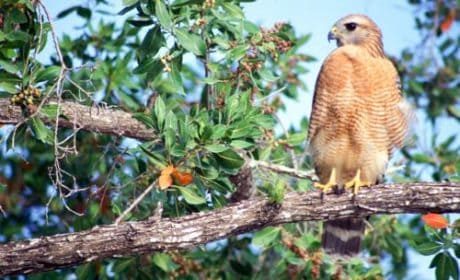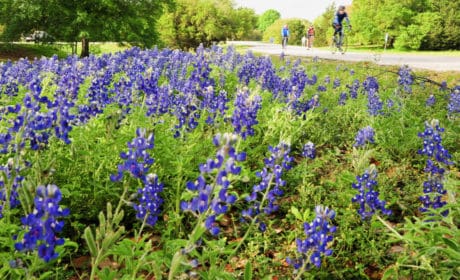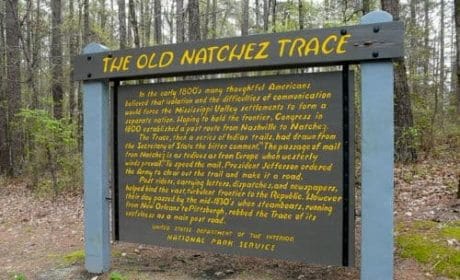Are you looking for fun things to do in Amarillo, Texas? The city makes an interesting Southwestern road trip stop that’s worth your time.
When a conference took travel writers Debi Lander and Judy Wells to South Dakota, they decided to make the most out of it and explore the Badlands and Mount Rushmore. They kept track of their adventures on a joint blog called Good Girls in the Badlands.
Sadly, Judy has passed on. However Debi fondly remembers that trip and the memories she and Judy created together. She is here to share their road adventure that included a tour of Amarillo’s most curious sites, along with a visit to the World Ranch Rodeo Championship.
We arrived at Rick Husband Airport, picked up our rental car and headed for downtown Amarillo, Texas, an area known for cowboys and cattle. We didn’t get very far because a sign grabbed our attention and we simply had to turn back.

You can’t miss the Big Texan Ranch Steakhouse advertisement featuring long-legged Big Tex, who hovers above the roadside establishment. The restaurant became a beacon for travelers along Route 66 back in its heyday and later grew into a sprawling complex along Interstate 40.
We naturally had to snap some photos of Big Tex, but the life-size model of an Angus cow makes for a better selfie.

In true Texas spirit, the now world-famous free 72-oz. steak dinner came to life not long after the restaurant opened. The Good Girls had no intention of trying to eat four and a half pounds of steak in one hour, even as a joint effort. However, if you can force that down, your dinner is free. If you’re like us, just go see the place.
Table of Contents
Stay in Amarillo at a convenient downtown location
We then drove into center city establishing our base at the Marriott Courtyard Downtown Amarillo in the lovely renovated Fisk office building. We noticed efforts underway to save and revitalize the downtown and heartily approved. Many structures date from the Art Deco era – or as they call it in Amarillo, Pueblo Deco – design motifs inspired by Pueblo sand paintings.
Things to do in Amarillo, Texas: Check out the funky museums

Eric Miller, head of the Amarillo Convention and Visitors Center, suggested an itinerary, starting with museum tours the next morning. First up, Jack and Trent Sizemore’s Travel and RV Museum.
Here, we found RVs from teeny tag-alongs to behemoths of the road displayed as you might have seen them used. Grills, chairs, toys and sports gear of appropriate era surrounded many.
“Do you remember-this” type memories popped up as we peeked inside and “traveled” through decades of harvest gold and avocado green kitchens, burnt orange shag carpeting and aqua bathrooms. Classic motorcycles fill wall space in the vast two-room industrial garage, and all come with signage on the history, restoration process, and other interesting details. The RV Museum earns a thumbs-up, a nostalgic stop for Boomers.

Next, we toured the American Quarter Horse Hall of Fame and Museum. From the exterior, we could tell this museum was well funded. You enter an impressive Grand Gallery where sidewall photographs provide a backdrop for bronze statues of racing, ranching and pleasure Quarter Horses and their breeders.

Interactive displays on the second floor follow the development of the American Quarter Horse. We finished with the introductory movie, a good way to reinforce the impact this horse has made in the history of our country.
Look for the Hoof Prints

As we drove around, we noticed and then started looking for another kind of horse. Hoof Prints is Amarillo’s answer to the pigs, fish and jaguars public art projects of other cities. This project by Center City, Amarillo and the American Quarter Horse Association has placed life-sized statues of Quarter Horses painted by regional artists around the area.
Center City Executive Director Beth Whitley Duke, “the mother of horses,” met us for coffee. She explained that what began with 20 horses in 2002 has grown to 103 unique works.
All are stallions except for two, a mare sponsored by Hooters and a spectacular mirrored mosaic mare and foal at the Women and Children’s Health Center. Visitors and locals use them as the object of family scavenger hunts, selfies and photography projects.
Admire Native American art and dance
Continuing on, we stopped by the Kwahadi Museum of the American Indian. The center or Kiva is the home of the world famous Kwahadi Dancers as well as an amazing collection of Native American art and artifacts.

The museum presents a varied collection of arts, books, costumes, artifacts, and paintings. You can see works by the late author and artist, Thomas E. Mails, covering 14 native cultures (check out his many books on Amazon). Nature enthusiasts love the detailed carvings of the Birds of the High Plains by Bob Jones.

We were surprised to learn that the dancers are not Native Americans. The group started as a World War II era Boy Scout project in 1944.
Performers are everyday Amarillo students, male and female (plus the occasional tag-along little brother or sister) who’ve been encouraged and inspired to join and learn. They perform at the museum throughout the year and travel during the summer and special occasions. They have danced in 48 states and overseas too.
The Elders of the Comanche Nation, who were also known as Kwahadis, gave the name to the young dancers. Their performances are based on Comanche dances but as interpreted by the Amarillo participants. Unfortunately, we were not in Amarillo when they were performing.
Roadside Attractions near Amarillo
Roadside attractions are an endearing American phenomenon, a way that places in the middle of nowhere become somewhere when people exercise creativity, put tongue in cheek and take advantage of wide open space.
Pick up a can of spray paint at Cadillac Ranch
Cadillac Ranch is a prime example. It, too, began life on Route 66 but a growing city prompted a move to Interstate 40.
The installation charting the evolution of Cadillac’s tail fins (1949-1963) was the brainchild of Chip Lord, Hudson Marquez and Doug Michels, part of the Art Farm group of architects and artists. They approached millionaire Stanley Marsh of Amarillo, who had a penchant for non-traditional art, and the rest is history: an installation of 10 Cadillacs partially buried nose down — supposedly at the same angle as the Great Pyramid of Giza in Egypt.

The afternoon we arrived it was relatively quiet for a weekend when 2,000 to 4,000 people are likely to drop by. During the week numbers run from 1,000 to 2,000 visitors.
What you do at the Cadillac Ranch is spray paint. At times, the cars were painted white for a commercial, pink for the birthday of Wendy, Stanley’s wife, and all were coated in black when Doug Michels died.
In 2012 the installation became a rainbow to commemorate gay pride. We marveled that people from all over the world have made a line of oddly placed cars their must-see and-do.
Folks arrive wanting to add their names, colors, thoughts or scribbles to the “bodies.” Cadillac Ranch has transcended itself and truly is a living work of art.
Take a look at the legs
We don’t remember where we first heard about “the big legs” but everyone we mentioned them to, shook their heads and muttered, “You want to see those things?”

Yes, we did, even after being told it was a joke and the official-looking plaque wasn’t. We persisted despite wrong turn after wrong turn.
Not knowing exactly what to look for, we were driving right by them. When we finally caught our first glance, the old Peggy Lee song, “Is that all there is?” came to mind and we understood the discouraging comments.
Then we saw the official-looking plaque supposedly quoting Shelley’s “Ozymandias” and started reading. And laughing.
Can’t you just imagine a group of beer-drinking students, undoubtedly an English major and an art major among them, sitting around coming up with a roadside attraction of their own?
We hear the crew sock marking and some graffiti were added after installation, so the legs may evolve into something deeper than an elaborate student prank. In the meantime, thanks for the laughs.
Meet Big Tex Randall
You don’t have to look hard for the roadside attraction of 47-foot-tall Tex Randall in Randall County. Tex began life in 1959 as what was then “Texas’ Biggest Texan.”
The seven-ton slouching cowboy was built of cement and steel for Wheeler’s Western Store on US 60. The store sold Western clothing, so the cowboy was outfitted with a bandana, a real Western-style shirt, and an enormous pair of Levi’s jeans. An ingenious network of steel struts and cables anchored him to the ground.

Decades passed and the Transportation Department rerouted US 60, cutting off traffic and putting the Western Store out of business. Panhandle winds shredded the cowboy’s canvas duds. A semi crashed into his left boot, and the cigarette was shot out of his right hand.
Local leaders rallied for a “Save the Cowboy” campaign in 1987. The no-longer-fashionable cigarette was replaced with a spur. The cowboy was given a new face with a mustache, a new set of painted-on clothes.
As the decades passed, powerful winds again ravaged Tex, sandblasting away large portions of his skin and clothes. A local businessman bought the cowboy but then learned it would cost $50,000 to move him.
Local boosters mounted an Internet fundraising campaign, but their efforts fell short. Time appeared to have run out for the big cowboy.
Boomer Travel Tip
Traveling on a United States road trip? Start with our USA Road Trip Planner.
Then an unlikely hero rode to the rescue: the Texas Department of Transportation, which in late 2013 set aside almost $300,000 to turn the land around Tex’s boots into a park. Locals raised enough money to “re-skin” the statue after the cowboy was found to be structurally sound.
Repairs began in November 2015, and we were lucky to see the new, better-clothed Tex. He’s no longer the “Biggest Texan, ” but he makes a fine icon for the Amarillo area.
Attend the WRCA Ranch Rodeo Championships
Finally, it was time to attend the event we’d come to see. Teams from ranches qualify by competing in 22 sanctioned Ranch Rodeos in Colorado, Kansas, Oklahoma, New Mexico, Texas and Wyoming throughout the year.
The WRCA Championship Ranch Rodeo in Amarillo goes on four days, with half the teams competing each night. Champions are announced on Sunday.

Sportsmanship is key and it is normal for one ranch to assist another, even during competition. If a team finds itself short of a rider, they can borrow one from a competing team!
From the moment the arena lights were dimmed and the announcer took to the microphone, excitement could be felt. The contestants rode in bearing flags from their state and ranch, and one rider circled the arena proudly presenting the American flag. The crowd sang a rousing version of the National Anthem.
Bronco riding

The first event was Bronco Riding. No bull-riding here, ranchers must break young horses, and these guys are the best of the bunch.
The rules say to “Ride as ride can” for eight seconds. Well, eight seconds can be awfully long when you are on a wild horse.
We shudder to think of the impact this takes on the body. Nonetheless, the cowboys hang on, trying to control their mount during the allotted time, and the action is electrifying.
Roping till you get them all

Next was Roping, officially Stray Gathering. A team of four riders enter one end of the arena while cattle enter the opposite.
The riders are timed as they try to single out and lasso a calf. Then, their helpers jump off their horses and tie the calf’s head and feet. When the steer can no longer escape, the clock is stopped.
Wild cow milking
Wild Cow Milking, another contest, had us all laughing. It includes another four-man team: a roper, milker and two muggers! Only the roper is on horseback. (Honestly, “mugger” is the official name.)
Cows were lassoed and held somewhat still by the muggers. The milker tries to fill a bottle while not being trampled and must run it up to a judge for verification.
The judge will verify by pouring the milk out of the bottle. Sometimes there is not enough milk and sometimes the cows break away. Only the roper emerges un-tromped on.
Team penning

Team Penning was another fun test. Teams of four riders are assigned a number. All the cattle are marked with numerals, so the contestants pick out the correctly numbered calves, and move them down to a pen at the opposite end of the arena.
Often two or three of the needed four are penned, but somehow they make a fast break and escape, causing the riders to start all over again. This task can take a l-o-o-o-n-g time to complete because most calves want to rejoin the herd. Never could figure out why one team member wasn’t left behind to tend the penned ones.

During an intermission, the Budweiser Clydesdales Team and Beer Wagon, complete with Dalmatian on top, entertained. These huge beasts combine power with grace.
We especially liked when they crisscrossed their hooves, side stepping to turn the wagon 180 degrees. To see these beautiful behemoths handle it like dainty ballet dancers is remarkable.
Team branding
Team Branding consists of four- to six-man teams: a roper, two flankers, a brander and two herd holders. Two calves must be roped and pulled to what is called the fire.
At the rodeo, dark chalk is used instead of branding with a hot iron. Two teams compete at the same time, so there are anxious moments between teams.
The night ended with a second group of competitors in Bronco Riding. The horses didn’t seem to buck as wildly as the first group, but maybe we’d just gotten familiar with the action. We both gained an appreciation of hard working cowboys and if we lived in Texas, we would definitely go again.
Explore Palo Duro State Park

On the last morning of the Good Girls trip, we rode out of town to the heart of the Texas Panhandle to visit Palo Duro Canyon State Park. We parked near the rim and began to understand why this is called the Grand Canyon of Texas. It is the second largest canyon in the country based on its length (120 miles) rather than depth.
The rim stands 3,500 feet above sea level, but the maximum depth is only 800 feet. The Grand Canyon in Arizona is 277 miles long, 18 miles wide, and 6,000 ft. deep.
We drove the park loop, stopping for photo ops rather than hiking a trail. Starting down the steep road, we paused once to appreciate the stunning view of the canyonlands.
Next stop was the trailhead to Lighthouse Trail, a 6-mile path to the most famous formation in the park. We crossed over streambeds six times and completed the loop, stopping again and just letting ourselves enjoy the beauty of the Southwest.
Amarillo offered much to see. Best of all, Judy and I left with a Western swagger and a taste of the cowboy life. Yee-Haw!
All photos by Debi Lander and Judy Wells.




